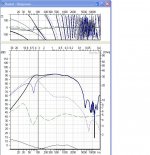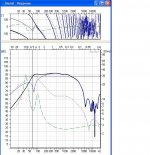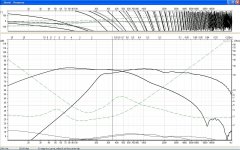So, I bought this super simulation software called Basta! I'm not advertising it, but I noticed while playing around with various woofers is that if I put a series RLC notch filter at the resonance point (higher one in a vented enclosure), the phase shift in that frequency range becomes much more mild. It doesn't change the SPL response, but I would like to ask if this is something that is worth doing? I can't tell from Basta! if it affects group delay or impulse response. I also do not know if any of these changes are audible. I've been wondering about this for a while and I'm glad I was able to finally model it.
In the attaches images, the phase response is the dashed line in the upper chart. The first one is with a notch filter tuned to the upper resonance, the second one is without a notch filter. In the lower charts, the dashed line is the impedance curve, the dotted line is the vent response, the solid blue line is the driver response and the thick black line is the system response. The two lines at the very bottom of the bottom charts are room gain to the left and baffle step loss to the right.
In the attaches images, the phase response is the dashed line in the upper chart. The first one is with a notch filter tuned to the upper resonance, the second one is without a notch filter. In the lower charts, the dashed line is the impedance curve, the dotted line is the vent response, the solid blue line is the driver response and the thick black line is the system response. The two lines at the very bottom of the bottom charts are room gain to the left and baffle step loss to the right.
Attachments
Last edited:
Only listening can tell.
I done it with my open baffle, the sound became better. The impedance curve became better, less load for the amplifier and flattened the bass response.
http://www.diyaudio.com/forums/multi-way/147812-big-passive-ob-project-4.html#post2691218
Troëls Gravesen have done the same thing with 2 of its designs, the sound seems to be better.
PRELUDE
Jenzen-NEXT
I done it with my open baffle, the sound became better. The impedance curve became better, less load for the amplifier and flattened the bass response.
http://www.diyaudio.com/forums/multi-way/147812-big-passive-ob-project-4.html#post2691218
Troëls Gravesen have done the same thing with 2 of its designs, the sound seems to be better.
PRELUDE
Jenzen-NEXT
Last edited:
Hi,
It only makes a difference if the amplifier has high output impedance.
A more succinct approach is to wire a say 33R 10w or 20W resistor
in parallel with the speakers, it will reduce phase shift for both the
vented peaks and typical midrange peaks, and flatten impedance.
rgds, sreten.
It only makes a difference if the amplifier has high output impedance.
A more succinct approach is to wire a say 33R 10w or 20W resistor
in parallel with the speakers, it will reduce phase shift for both the
vented peaks and typical midrange peaks, and flatten impedance.
rgds, sreten.
Hi,
It only makes a difference if the amplifier has high output impedance.
A more succinct approach is to wire a say 33R 10w or 20W resistor
in parallel with the speakers, it will reduce phase shift for both the
vented peaks and typical midrange peaks, and flatten impedance.
rgds, sreten.
OK. Thanks .
I tried the 33R resistor and it does lower the impedance peaks and phase shift a little bit but not nearly as much as a series RLC notch filter tuned to one of the impedance peaks, according to Basta! anyway....
Otherwise, I can't see any effect from it in Basta! on things like cone excursion, amplifier voltage, maximum SPL or other parameters.
Only listening can tell.
I done it with my open baffle, the sound became better. The impedance curve became better, less load for the amplifier and flattened the bass response.
http://www.diyaudio.com/forums/multi-way/147812-big-passive-ob-project-4.html#post2691218
Troëls Gravesen have done the same thing with 2 of its designs, the sound seems to be better.
PRELUDE
Jenzen-NEXT
Thanks. I think I'll give this a try and see if I can hear a difference. It's nice to know that others have done something similar. I know I'm not completely crazy that way.
One bad thing I'm seeing is that the typical notch filter calculator makes the R value so low that it brings down the impedance too much. In Basta! I'm raising the R value of the RLC filter to keep the impedance above 3 or 4 ohms. But oh what a nice flat phase curve! I just need an amp that's good for 25 watts into 2 or 3 ohms...
Attachments
Hi,
The phase of the loudspeakers response does not change one iota.
Flat phase regarding the drive current is fairly meaningless and
not worth chasing. The cost of the parts is typically prohibitive.
High phase angles with high impedance is not an issue for amplifiers.
High phase angles with low impedance is a typical amplifier killer.
Your not fixing anything. Your playing with the wrong things in Basta! IMO.
rgds, sreten.
The phase of the loudspeakers response does not change one iota.
Flat phase regarding the drive current is fairly meaningless and
not worth chasing. The cost of the parts is typically prohibitive.
High phase angles with high impedance is not an issue for amplifiers.
High phase angles with low impedance is a typical amplifier killer.
Your not fixing anything. Your playing with the wrong things in Basta! IMO.
rgds, sreten.
Last edited:
Hi,
It only makes a difference if the amplifier has high output impedance.
A more succinct approach is to wire a say 33R 10w or 20W resistor
in parallel with the speakers, it will reduce phase shift for both the
vented peaks and typical midrange peaks, and flatten impedance.
rgds, sreten.
By midrange peak- I assume you mean the peaking from the M/H XO?
By midrange peak- I assume you mean the peaking from the M/H XO?
Hi, Yes. On paper you can make the impedance look more benign, rgds, sreten.
Adding a resistor in parallel with the woofer didn't do anything to the midrange SPL response according to my simulations in Basta! It only slightly lowered the resonance peaks. You presumably already have an RLC resonance notch filter on the midrange and tweeter, so why add a resistor there? Doesn't make sense to me.
Adding a resistor in parallel with the woofer didn't do anything to the midrange SPL response according to my simulations in Basta! It only slightly lowered the resonance peaks. You presumably already have an RLC resonance notch filter on the midrange and tweeter, so why add a resistor there? Doesn't make sense to me.
Hi,
Its not supposed to, just as adding a bass RLC makes no difference to
the speakers response except for high output impedance amplifiers.
Like I said, its makes the impedance and phase appear to be more benign.
It might be tweak that works with valve amplifiers, reducing interaction.
rgds, sreten.
In Basta! try adding a 2R series resistance for amplifier source
impedance, then you will find these things do change response.
Last edited:
Hi,
Its not supposed to, just as adding a bass RLC makes no difference to
the speakers response except for high output impedance amplifiers.
Like I said, its makes the impedance and phase appear to be more benign.
It might be tweak that works with valve amplifiers, reducing interaction.
rgds, sreten.
In Basta! try adding a 2R series resistance for amplifier source
impedance, then you will find these things do change response.
Your 33 ohm resistor didn't appear to do much of anything to the midrange portion of the impedance curve for the woofers I simulated in Basta! (using their standard amplifier with low output Z) If anything, it lowers the impedance slightly in the midrange.
Your 33 ohm resistor didn't appear to do anything to the midrange portion of the impedance curve for the woofers I simulated in Basta! (using their standard amplifier with low output Z) If anything, it lowers the impedance slightly in the midrange.
Hi,
Cross the driver over to a tweeter, checkout the impedance, add the 33R.
rgds, sreten.
Simulators are great for illustrating stuff, but poor for understanding it.
Working out whats going on still requires the spadework involved.
Last edited:
Hi,
Cross the driver over to a tweeter, checkout the impedance, add the 33R.
rgds, sreten.
OK, I think I see what you're saying. You mean that the way the impedance of the driver with a low pass filter goes sky high on the higher frequency side of the crossover point is reduced by this resistor. I see the effect in Basta! but the SPL response doesn't change. I wasn't aware that high impedance was a problem for most amplifiers, only really low impedance.
Hi,
I'm not going to turn this into explaining the basics.
A tool is only as good as how well it is used.
rgds, sreten.
http://sites.google.com/site/undefinition/diy
(see if nothing else, the excellent FAQs)
The Speaker Building Bible - Techtalk Speaker Building, Audio, Video, and Electronics Customer Discussion Forum From Parts-Express.com
Zaph|Audio
FRD Consortium tools guide
Designing Crossovers with Software Only
RJB Audio Projects
Jay's DIY Loudspeaker Projects
Speaker Design Works
HTGuide Forum - A Guide to HTguide.com Completed Speaker Designs.
DIY Loudspeaker Projects Troels Gravesen
Humble Homemade Hifi
Quarter Wavelength Loudspeaker Design
The Frugal-Horns Site -- High Performance, Low Cost DIY Horn Designs
Linkwitz Lab - Loudspeaker Design
Music and Design
Great free SPICE Emulator : SPICE-Based Analog Simulation Program - TINA-TI - TI Tool Folder
I'm not going to turn this into explaining the basics.
A tool is only as good as how well it is used.
rgds, sreten.
http://sites.google.com/site/undefinition/diy
(see if nothing else, the excellent FAQs)
The Speaker Building Bible - Techtalk Speaker Building, Audio, Video, and Electronics Customer Discussion Forum From Parts-Express.com
Zaph|Audio
FRD Consortium tools guide
Designing Crossovers with Software Only
RJB Audio Projects
Jay's DIY Loudspeaker Projects
Speaker Design Works
HTGuide Forum - A Guide to HTguide.com Completed Speaker Designs.
DIY Loudspeaker Projects Troels Gravesen
Humble Homemade Hifi
Quarter Wavelength Loudspeaker Design
The Frugal-Horns Site -- High Performance, Low Cost DIY Horn Designs
Linkwitz Lab - Loudspeaker Design
Music and Design
Great free SPICE Emulator : SPICE-Based Analog Simulation Program - TINA-TI - TI Tool Folder
I love it... yes, no, but.🙂I'm not going to turn this into explaining the basics.
DiyAudio (Sreten) explaining the basics.
I don't think anyone's talking down to you as such - there's some good reading there.
Another one I'd add is Wayne's crossover document at Pi Speakers - unmatched quality and state-of-the-art performance .
To see the effect of your series tuned filter foget about looking at the woofer in isolation. Simulate a 2way speaker with a textbook crossover and real driver impedances and see how bad the response come out... then play with flattening the impedances and see how it effects things.
If you use a full range driver on an amp with a really high output impedance then you may want to flatten the driver impedance to get a flat response... of course you may want to consider a properly designed amp first!
John
Another one I'd add is Wayne's crossover document at Pi Speakers - unmatched quality and state-of-the-art performance .
To see the effect of your series tuned filter foget about looking at the woofer in isolation. Simulate a 2way speaker with a textbook crossover and real driver impedances and see how bad the response come out... then play with flattening the impedances and see how it effects things.
If you use a full range driver on an amp with a really high output impedance then you may want to flatten the driver impedance to get a flat response... of course you may want to consider a properly designed amp first!
John
I don't think anyone's talking down to you as such - there's some good reading there.
Another one I'd add is Wayne's crossover document at Pi Speakers - unmatched quality and state-of-the-art performance .
To see the effect of your series tuned filter foget about looking at the woofer in isolation. Simulate a 2way speaker with a textbook crossover and real driver impedances and see how bad the response come out... then play with flattening the impedances and see how it effects things.
If you use a full range driver on an amp with a really high output impedance then you may want to flatten the driver impedance to get a flat response... of course you may want to consider a properly designed amp first!
John
Thanks. It'll take a while for me to read that since I have a full time job. I'm familiar with Pi speakers from their website.
I'll have to get some other software in order to measure and import real driver data into Basta! I did simulate the woofer as you described using just the manufacturer's data but the notch filter didn't seem to do much of anything different that I could see. I'm still learning about all the features of Basta! so maybe I'm missing something. It does seem like a very sophisticated piece of software.
Another one I'd add is Wayne's crossover document at Pi Speakers - unmatched quality and state-of-the-art performance .
John
I read through most of the article but I did not see where he used a series RLC notch filter across the woofer. I am familiar with most of the material in his article, but what I didn't like was his approach to crossover design. Maybe he wasn't intending to show that, but to just show the interaction of component instead, I don't know. I suppose this means that this kind of filter isn't considered useful? That's all I really wanted to know anyway. One person on this thread said it was useful and another said it was not. I don't know which is right.
Also, I assume you were referring to this article:
http://www.pispeakers.com/Speaker_Crossover.pdf
Last edited:
Sorry Dirk, it's been a while since I looked at it. You're right, Wayne uses RC in parallel to flatten the inductive impedance rise - but the principal is the same. Simulating a perfect voltage source into the driver impedance alone will not change with or without the additional components, but if you simulate the driver with crossover it becomes clear.
As mentioned earlier, if you simulate using a voltage source with series resistance you'll also see a change in response. Never used Basta though, I tend to use Aimspice or LT Spice along with the S&L WT2.
As mentioned earlier, if you simulate using a voltage source with series resistance you'll also see a change in response. Never used Basta though, I tend to use Aimspice or LT Spice along with the S&L WT2.
- Status
- Not open for further replies.
- Home
- Loudspeakers
- Multi-Way
- Woofer Resonance Notch Filters


